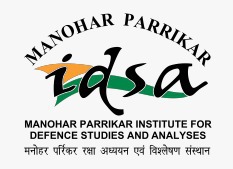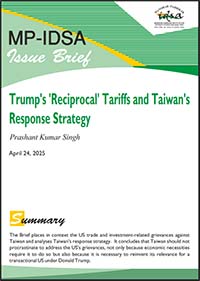Trump’s ‘Reciprocal’ Tariffs and Taiwan’s Response Strategy
- April 24, 2025 |
- Issue Brief
Summary
The Brief places in context the US trade and investment-related grievances against Taiwan and analyses Taiwan’s response strategy. It concludes that Taiwan should not procrastinate to address the US’s grievances, not only because economic necessities require it to do so but also because it is necessary to reinvent its relevance for a transactional US under Donald Trump.
Taiwan was among countries at the receiving end of President Donald Trump’s so-called reciprocal tariffs announced on 2 April 2025.[1] The Trump administration imposed 32 per cent tariff on Taiwanese products.[2] Later, it universally paused the tariff hike for 90 days, except for China, but retained 10 per cent base increase.[3] The Trump administration has been indiscriminate in tariff hikes, targeting allies, partners and rivals alike. In its understanding, tariffs are a strategy for “reciprocity, investment, and reindustrialisation”[4] and also for national security.[5] The indiscriminate tariff hike has conveyed that Trump prefers redressal of US trade and investment related grievances over security and strategic commitments towards the US’s traditional allies and they should not take its commitments for granted. Taiwan is one such traditional, albeit informal, ally.
This Brief studies the US’ ‘charge sheet’ against Taiwan. It relies on the 2025 National Trade Estimate Report on Foreign Trade Barriers of the President of the United States on the Trade Agreements Program, prepared by the Office of the United States Trade Representative (USTR) and published in March 2025.[6] It also draws on President Lai Ching-te’s “remarks on US tariff policy response,” delivered on 6 April 2025, to place in context Taiwan’s response.[7]
Bilateral Economic Ties
Taiwan and the US enjoy deep economic ties. The latest Congressional Research Service (CRS) brief, ‘U.S.-Taiwan Trade and Economic Relations’, provides key statistics. Taiwan ranks at number seven, with goods trade valued at USD 158.6 billion, among US’s merchandise trading partners in 2024. Taiwan was its 10th largest export market, with USD 42.3 billion exports, out of which agriculture accounted for USD 3.8 billion and services USD 11.9 billion. Taiwan was also the eighth largest source of imports from where the US purchased USD 116.3 billion worth of products.[8]
The US incurred USD 74 billion trade deficit with Taiwan in 2024. Taiwan’s exports to the US have seen a steep rise from 2018 onwards, partly because the US’s increased tariffs on China compelled some exporters to shift to Taiwan. They have substantial investment links as well, with the US’s USD 19.3 billion in direct investment stock in Taiwan and Taiwan’s USD 15.6 billion in direct investment stock in the US, as per the 2023 data. Presently, USD 290.4 billion out of Taiwan’s USD 578 billion forex reserves are invested in US Treasuries.[9]
The two sides instituted a U.S. Taiwan Initiative on 21st Century Trade in 2022 to resolve issues related to “trade facilitation, regulatory practices, digital trade, anti-corruption, technical standards, labour and environment, agriculture, state-owned enterprises, and nonmarket practices.”[10] They concluded their first agreement in 2023 under the initiative.[11] In 2021, they resumed their trade and investment talks under the 1994 Trade and Investment Framework Agreement (TIFA) talks, which had not taken place since 2016.[12] In 2020, they set up an annual U.S.-Taiwan Economic Prosperity Partnership Dialogue to discuss supply chain security, China’s economic coercion, digital trade and other issues of mutual interest.[13]
The US ‘Charge sheet’ against Taiwan
The 2025 USTR Report lists the difficulties faced by US exporters in accessing the Taiwanese market. The complaints are about tariffs and taxes, non-tariff technical and sanitary and phytosanitary barriers. Complaints about hindrances in accessing agricultural and livestock market dominate the US ‘charge sheet.’ A summary of the US complaints is as follows:
Unfavourable and Biased Tax Structure
The US says that “Taiwan’s average Most-Favored-Nation (MFN) applied tariff rate was 6.5 percent in 2023,”[14] but its actual average World Trade Organisation (WTO) bound tariff rate is 6.8 percent. Besides, although Taiwan removed many tariff-rate quotas (TRQs) after joining the WTO in 2002, it still retains several TRQs on agriculture, covering 16 agricultural products, which provides it “recourse to special safeguards (SSGs) for agricultural products.”[15]
Under the SSGs, Taiwan can “impose additional duties when import quantities exceed SSG trigger volumes or import prices fall below SSG trigger prices,” but since it “previously did not import many of these products, its SSG trigger volumes are relatively low.”[16] This helps it restrict agricultural imports from the US. Further, in regard to higher taxes, the US gives the example of rice wine for cooking (mijiu), which can be consumed as alcoholic beverage, but Taiwan does not treat it as alcoholic beverage and taxes it lower than the rate imposed on imported alcoholic beverages. The US finds this unfair.[17]
Uncertain Quantitative Restrictions, Unfair Customs Barriers and Unreasonable Inspections
As an example of uncertainty in quantitative restrictions, the US believes that its rice exporters have not been able to utilise the country quota under Taiwan’s country specific quota (CSQ) regime, possibly due to Taiwan’s non-transparent ceiling price mechanism. It complains that many times the US rice exporters’ bids invited under the US quota were rejected and they were informed that their bids were above the ceiling price mechanism after which the import orders were released to global tender. Although US rice exporters were able to utilise their CSQ in 2023 and 2024, concerns about possible manipulation continue.[18]
As for customs barriers, the Trump administration does not agree that genetically engineered (GE) and non-GE raw materials, such as corn and soybeans, should “enter under separate tariff lines” because, according to it, “there is no scientific or technical basis for Taiwan’s separate tariff lines for GE and non-GE raw materials.”[19] It maintains that GE products undergo more rigorous evaluation by regulatory authorities and after approval, they become part of the same agricultural supply chain. Further, it accuses Taiwanese authorities of indulging in frequent and unreasonable inspections of the businesses “handling U.S. pork, including importers, distributors, and food services,” disrupting their normal functioning in order to discourage “them from purchasing US pork.”[20]
Technical, Sanitary and Phytosanitary Barriers
The US has a further grievance against Taiwan’s stringent health safety measures that, in its view, unfairly targets beef, pork and potato imports from the US. It argues that Taiwan’s health safety measures against their import are not based on science. US beef and beef products imports to Taiwan have historically been contentious. In 2003, an animal with bovine spongiform encephalopathy (BSE) was detected in the US. After this, Taiwan banned beef imports from the US. In 2009, Taiwan lifted the ban, but later introduced many stringent measures, some of which were relaxed in 2021. The BSE chapter is not yet closed.
Imports of certain US beef products such as ground beef remain banned in Taiwan. The US complains that certain U.S. beef offal products face “onerous port-of entry inspection procedures that are not science-based.”[21] It demands that Taiwan follow the World Organization for Animal Health (WOAH) guidelines and fully open its market to US beef and beef products. The WOAH guidelines “recognise these commodities as safe-to-trade, regardless of the BSE risk status of the exporting country.”[22]
The US complains against labelling requirements for its pork products, which it views as a technical barrier to pork exports to Taiwan. It does not agree with Taiwan implementing the Codex Alimentarius Commission (Codex) beta-agonist maximum residue limits (MRLs) for ractopamine in imported pork muscle, fat, liver and kidney.[23] It argues that Taiwan’s MRL risk assessment “is not based on a realistic exposure scenario” and is not aligned with the Joint Food and Agriculture Organization and World Health Organization Expert Committee on Food Additives guidelines. The US claims that Taiwan implements MRL only for ractopamine, not for other beta-agonist compounds, but does not explain the rationale behind this selective implementation. The US demands Taiwan “implement science-based and risk-based MRLs without undue delay.”[24]
The US has similar grievances and demands regarding agrochemical MRLs implemented by Taiwan for pesticides. It complains that Taiwan has occasionally rejected entire “shipments of U.S. chipping potatoes due to… specific restrictions on sprouting for imported potatoes… even though sprouting does not pose a food safety risk.”[25] It also objects to Taiwan’s ban on “the use of biotechnology food ingredients and processed food with biotechnology food ingredients in school meals.”[26]
Other Complaints
Taiwan’s Ministry of Transportation and Communications (MOTC) guidelines allow it to import only a limited number of US Federal Motor Vehicle Safety Standards (FMVSS)-compliant vehicles if they are not the United Nations Economic Commission for Europe (UNECE)-compliant.[27] In the pharmaceuticals sector, US companies face the “non-transparent” and “unpredictable” nature of Taiwan’s National Health Insurance Administration’s (NHIA) “pricing approval procedures.”[28] It also complains against the NHIA’s administrative penalties on hospitals if they “ask patients to self-pay for devices without a self-pay code.”[29]
The other major concern the report highlights relates to restrictions on foreign investment in Taiwan that vary from no foreign investment “in the manufacturing of certain chemical materials and metals, television and radio programming services, electricity transmission and distribution, and postal activities”[30] to 49 per cent direct ownership and 60 per cent, combined with the local partner, in the telecommunications sector. Similar restrictions are in place for direct ownership in domestic cable television, satellite television, shipping, airline, airport ground handling, air cargo terminal, catering companies.
Currency Manipulation
Furthermore, the US has concerns about possible currency manipulation by Taiwan. In 2020, the US Treasury Department put Taiwan under monitoring in its currency monitoring report to track its currency practices and macroeconomic policies. It viewed them with a concern due to Taiwan’s “large trade account surplus and foreign exchange reserves.”[31] It has been on the monitoring list ever since.
Taiwan Stresses Mutual Benefits
The aforementioned grievances are long standing and have been part of US-Taiwan trade negotiations in the past.[32] Therefore, the Taiwanese side has been prepared to marshal its own statistics to prove the mutually beneficial nature of bilateral economic relations. A booklet, issued by the Taipei Economic and Cultural Representative Office (TECRO) in the United States, informs that the US was Taiwan’s’ second largest trading partner in 2023.[33] It apprises that not only Taiwanese exports but US exports to Taiwan also registered a substantial growth from 2018 to 2023. The US services exports to Taiwan increased by 20 per cent and its goods exports increased by 30 per cent during the same period. The booklet informs that Taiwan’s economic ties are spread across the US and the increase in US exports to Taiwan has been from across the US. The increase came from “more than two-thirds of US states,” with “more than half of them [growing] their exports by at least 30%.”[34]
Regarding the contentious issue of agricultural exports, the booklet underlines that Taiwan was the seventh largest export market for US agricultural products. Furthermore, it underscores the job creating nature of Taiwanese investment in the US. It informs that Taiwan “supported” 360,440 jobs in the US in 2023, out of which Taiwanese companies “supported” 156,880 jobs from the total job supported. US goods exports to Taiwan “supported” 145,550 jobs whereas US services exports to Taiwan “supported” 58,010 jobs. Taiwan has enabled job creation in most US states.[35]
TECRO informs that the period from January-November 2024 registered around 13.67 per cent growth in US investments in Taiwan, whereas Taiwanese investments in the US saw a 45.89 per cent increase.[36] It highlights that presently, the US is Taiwan’s largest investment destination, with a 31.78 per cent share in Taiwan’s outbound investments.[37] In addition to this, Taiwan highlights convergence and congruence in their economic security policies in terms of creating clean and trusted supply chains.
Taiwan’s Response: A Five-Pronged Strategy
Trump’s imposition of increased tariffs did not come as a surprise. President William Lai Ching-te gave a restrained response shunning any retaliation, maintaining that the issue requires a measured and nuanced response. He urged the industry and people, “please do not panic,” as the increase was not going to cause any grave economic instability.[38] He reminded them that Taiwan’s exports to the US accounted only for 23.4 percent of its total exports in 2024. More than 75 percent of its exports were destined to other countries. Besides, 65.4 per cent of its US-bound exports were ICT products and electronic components in which Taiwan enjoys a competitive advantage. Thus, enough resilience was available in the economy.[39]
Lai has offered a five-pronged strategy to address the issue at hand and make Taiwan’s economy more resilient.[40] The first prong is to negotiate with the US and address its legitimate concerns. He reassures the US that Taiwan would buy more from it and invest more in the country. He recognises the validity of the US’s sentiments about non-tariff barriers. He approves of US concerns about high-tech export controls and the illegal transhipment of dumped goods (illegal transhipment of dumped goods, or “country-of-washing”, denotes the problem of countries, particularly some southeast Asian countries, becoming proxy manufacturing hubs for Chinese companies, who seek to circumvent US trade restrictions).[41] He is willing to address them in order to facilitate negotiations.
The second prong is to support industries hit by the tariffs. The government has already identified nine areas and announced 20 measures for them. The other three prongs cater to making the economy more resilient. The third prong emphasises creating an even more complete ecosystem by integrating “the upper, middle, and lower reaches of industrial supply chains.”[42] He envisages semiconductor, integrated chip design, ICT, and smart manufacturing taking the lead and turning Taiwan “into an AI island.”[43] He envisions the same for military and security industries and also for industries such as medical and health and wellness.
The fourth prong promotes “Taiwan plus one,” to expand Taiwan’s global presence with firm local roots. The US is to be the centrepiece of these globalising efforts. Lai strikes a balance between safeguarding the domestic industrial base and US pressures to open further. This balance is important as Taiwanese semiconductor industry has recently faced pressure to manufacture in the US.[44] Hence, he has stressed on incentivising investments, deregulation, and resolving the issues such as access to water, electricity, land, human resources, and professional talent to keep Taiwan attractive for local and foreign manufactures. He reassures Taiwanese stakeholders that gaining further access to US markets is as much a priority as is further opening Taiwan to the US. The final prong is to deepen the channels of feedback from the industry by organising industry listening tours led by the top levels of the government.
Recent Actions
Taiwan has initiated negotiations with the US on the tariffs. Taiwanese negotiators held a video meeting with their US counterparts on 11 April. The details of the discussions have not been made public yet, but another round of discussions is scheduled soon.[45] Meanwhile, the Taiwan government has promised to prepare a “new support plan based on industry impact assessments.”[46] It has identified nine key areas out of which six belong to the industrial sector. It has assured providing financial support, reducing administrative costs, enhancing industry competitiveness, developing diverse markets, offering tax incentives and stabilising employment in these industrial areas. The three other identified key areas belong to the agricultural sector, which is also to be provided financial incentives, support to enhance its industry competitiveness and develop diverse markets for it. It has proposed 20 measures for these nine key areas, which include loan incentives, tax reductions, and helping diverse markets among others. It has announced a USD 2.7 billion budget to stabilise the economy.[47]
Conclusion
In addition to the trade balance, three other factors—military spending, toughness on China and anti-U.S. policies— should shape overall US policy for economic security. These four factors collectively make up a Trump Risk Index, which Information Technology & Innovation Foundation (ITIF), a Washington D.C.-based think tank, has created. Taiwan’s score is quite low on this index.[48] As of now, the Trump administration has been indiscriminate in applying increased tariffs and the trade balance appears to be the only criteria. However, as the situation evolves, the other factors mentioned earlier should also come into play. It is unlikely that the US would continue to paint its steadfast partners, such as Taiwan, with whom it has strong convergence of strategic interests’ vis-à-vis China, which is the US’ principal strategic rival, with the same brush.
A perusal of the US ‘charge sheet’ against Taiwan reveals that US concerns pertain mainly to agricultural and livestock sectors, which constitute only a small portion of bilateral economic ties, though the tariff hike applies across the spectrum. In December 2024, Taiwan’s Central Bank assessed that since “complicated and irreplaceable” semiconductors and information and communications technology (ICT) products dominate Taiwan’s exports to the US, the impact of tariff hikes on those industries, and thus, on Taiwan, “could be limited.”[49] Yet the tariff hike issue, if left unaddressed, has the potential to “dilute Taiwan’s semiconductor resources, hurt [its] industrial clusters as a whole and affect exports, investments and employment.”[50]
The positive side in this episode is that the two sides have already been engaged in discussions and have been negotiating on contentious issues. Besides, Taiwan has shown willingness to address the US’s grievances. Therefore, the tariff issue alone does not appear to pose any instability in US-Taiwan ties. Nevertheless, Taiwan should take the increased tariff as a reminder to iron out differences with the US regarding trade and investment-related issues for economic reasons as well as security considerations, because it cannot afford strained relations with its sole security guarantor in the world against unilateral use of force by China.
Furthermore, this is also an opportunity for Taiwan to have a serious re-look at its macroeconomic policies. The calculations used by the Trump administration to determine tariff rates imposed by countries on the US products are being questioned everywhere. Also, trade deficits are not the result of trade barriers only. They are largely a function of what one has to sell and what one needs to buy and how much one can pay for what one wants to buy. However, the fact remains that Taiwan has had an enormous surplus for more than two decades. Its average trade surplus from 2013 to 2023 was 13 per cent of its gross domestic production (GDP) which increased to 15 per cent in 2024.[51]
Economist Chang-tai Hsieh analyses this issue and points out that “no other country in the world has run trade surpluses as large as Taiwan’s for as long as Taiwan has,”[52] and strongly indicates that Taiwan has been able to achieve this feat by manipulating the value of its currency— by keeping the Taiwan dollar deliberately undervalued.[53] The implication of this large trade surplus is that it makes free trade agreements unattractive for most countries. Thus, Hsieh argues that the tariff hikes on Taiwan was “not only Trump’s war with the world but is also the consequence of many years of distortionary macroeconomic policy in Taiwan.”[54]
The challenge for Taiwan is to keep itself relevant for the US in these times of “a selfish pursuit of national interest” and package itself “in ways that resonates” with the Trump administration.[55] Beyond the US, it also needs to present itself as a fair partner to the world.
Views expressed are of the author and do not necessarily reflect the views of the Manohar Parrikar IDSA or of the Government of India.
[1] Elisabeth Buchwald, Antoinette Radford, et al., “April 2, 2025 – Liberation Day Tariff Announcements”, CNN Business, 3 April 2025.
[2] Elaine Hou and Christie Chen, “Trump Announces 32% Tariff on Imports from Taiwan,” Focus Taiwan, 4 April 2025.
[3] “Modifying Reciprocal Tariff Rates to Reflect Trading Partner Retaliation and Alignment”, The White House, 9 April 2025.
[4] Kwangyin Liu, “Trump’s Tariff Offensive is More than Economics: What He Really Wants” Commonwealth Magazine, 8 April 2025.
[5] “Fact Sheet: President Donald J. Trump Ensures National Security and Economic Resilience through Section 232 Actions on Processed Critical Minerals and Derivative Products,” The White House, 15 April 2025.
[6] “2025 National Trade Estimate Report on Foreign Trade Barriers of the President of the United States on the Trade Agreements Program”, Office of the United States Trade Representative (hereafter USTR report), March 2025.
[7] “President Lai Delivers Remarks on US Tariff Policy Response”, Office of the President, 6 April 2025.
[8] “U.S.-Taiwan Trade and Economic Relations”, Congress.Gov, 10 April 2025.
[9] Ibid.
[10] Ibid.
[11] “Agreement between the American Institute in Taiwan and the Taipei Economic and Cultural Representative Office in the United States regarding Trade between the United States of America and Taiwan”.
[12] “U.S.-Taiwan Trade and Economic Relations”. The US had suspended the talks intermittently between 2027 and 2013 on the issue of Taiwan banning pork and beef imports from the US because they contained “a leanness-enhancing additive”.
[13] Ibid.
[14] “2025 National Trade Estimate Report on Foreign Trade Barriers of the President of the United States on the Trade Agreements Program”, n. 6, p. 333.
[15] Ibid.
[16] Ibid.
[17] Ibid., p. 334.
[18] Ibid., p. 334.
[19] Ibid., p. 334.
[20] Ibid.
[21] Ibid. p. 335.
[22] Ibid. p. 335-336.
[23] Ibid. p. 336.
[24] Ibid.
[25] Ibid.
[26] Ibid. p. 335.
[27] Ibid.
[28] Ibid. p. 338.
[29] Ibid. p. 338.
[30] Ibid. p. 337.
[31] “U.S.-Taiwan Trade and Economic Relations”, n. 8.
[32] Riley Walters, “Towards a Second Agreement of the US-Taiwan 21st Century Trade Initiative”, Global Taiwan Institute, 15 May 2024,
[33] “Taiwan Trade & Investment: Creating and Supporting American Jobs,” Taipei Economic and Cultural Representative Office (TECRO) in the United States, Washington, D.C., p. ii.
[34] Ibid., p. iv.
[35] Ibid. p. iii.
[36] “Taiwan-U.S. Economic Relations”, TECRO, 8 April 2025.
[37] Ibid.
[38] “President Lai Delivers Remarks on US Tariff Policy Response”, n. 7.
[39] Ibid.
[40] Ibid.
[41] Liu, “Trump’s Tariff Offensive is more than Economics: What He Really Wants”, n. 4.
[42] “President Lai Delivers Remarks on US Tariff Policy Response”, n. 7.
[43] Ibid.
[44] “TSMC’s U.S. Expansion may Ease Tariff Risks: Analysts,” Focus Taiwan, 4 Mach 2025.
[45] Yu-chen Lai, and Tina Wu, “Taiwan, U.S. expect new round of tariff talks soon: Executive Yuan,” Focus Taiwan, 16 April 2025.
[46] “Premier Announces Economic Stability Plan in Response to US Tariff Policy”, Executive Yuan, 4 April 2025.
[47] Ibid.
[48] Robert D. Atkinson, and Trelysa Long, “Which US Allies Are Most Likely to Face Trump Tariffs—and How Can They Avoid the Wrath of an “America First” Doctrine?” Information Technology and Innovation Foundation, December 2024.
[49] Tzu-yu Pan and Frances Huang, “Taiwan to See Low Tariff Risks amid Trump Threats: Central Bank”, Focus Taiwan, 28 December 2024.
[50] Ibid.
[51] Chang-tai Hsieh, “Why Taiwan Got Slammed with a 32% Tariff — and Why It’s Partly to Blame”, Commonwealth Magazine, 10 April 2025.
[52] Ibid.
[53] Chang-tai Hsieh, “Taiwan’s Never Ending Trade Surplus”, Commonwealth Magazine, 25 November 2024.
[54] Hsieh, “Why Taiwan Got Slammed with a 32% Tariff — and Why It’s Partly to Blame, n. 51.
[55] Pei-ju Teng, “U.S. Expert Warns of Shifting Geopolitics, Urges Taiwan to Align with Trump”, Focus Taiwan, 19 December 2024.





